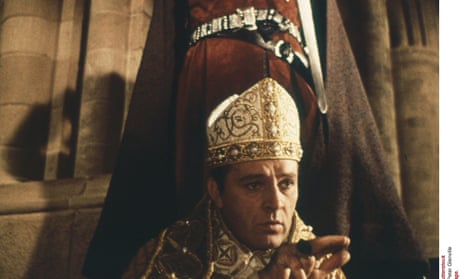A bloodstained tunic belonging to Thomas Becket is to be returned to Britain from the Vatican to help mark the 850th anniversary of the murder of the former archbishop of Canterbury and the 800th anniversary of the creation of his shrine.
Canterbury Cathedral, where Becket was killed in December 1170 following a bitter dispute with King Henry II, became a shrine after Pope Alexander III made Becket a saint following the murder. It drew thousands of pilgrims from England and across Europe until the shrine was destroyed in 1538 by Henry VIII.
In recent times the site of Becket’s murder has again attracted visitors, and Canterbury Cathedral is to host a series of celebrations in 2020 to mark the anniversaries, including a major church service, jointly held by Catholics and Anglicans, and an exhibition of artefacts linked to Becket.
Given the destruction during the Reformation, when Henry VIII broke with Rome and ordered the dissolution of the monasteries, Canterbury itself has little left of Becket’s body or his belongings. But the tunic – or more properly tunicle, a garment worn to celebrate mass – escaped destruction because it was given to the pope by Henry’s father, Henry VII, 50 years earlier and kept in Rome. It has since been housed in the Basilica of Santa Maria Maggiore, one of the great papal churches of Rome.
Negotiations have been going on for some time between the Vatican and the Church of England over how to commemorate Becket’s anniversary, including the loan of the tunic. Among those also involved have been the Foreign Office – via the British embassy to the Holy See – and Father Robert McCulloch, procurator general of the Missionary Society of St Columban, who suggested the tunic might be loaned to Canterbury.
He said: “The archives of the Basilica of Santa Maria Maggiore show that the tunic has been kept there since 1485. There is a theory that Henry VII gave the tunic of a great English saint and martyr to the then pope because he wanted to please him as he was trying to get him to canonise Henry VI. If Henry VI was made a saint, Henry VII thought this would put his House of Tudor, with its links to the Lancastrian Henry VI, in a good light. It’s ironic that his son, Henry VIII, then broke with Rome and had Becket’s shrine destroyed.”
Devotion to Becket by pilgrims from all walks of life inspired Chaucer’s Canterbury Tales, and in the 20th century he was the subject of TS Eliot’s verse drama Murder in the Cathedral. Another play, by French playwright Jean Anouilh, was the inspiration for the 1964 film Becket, starring Richard Burton as Thomas Becket and Peter O’Toole as Henry II.
The killing of Becket shocked Catholic Europe to the core. The archbishop had long been a close friend of Henry II but they fell out, with spectacular rows over whether the crown or the church had more authority over the clergy and the people. Outraged by Becket’s defiance of him, Henry is reported to have said the now-famous line: “Will no one rid me of this turbulent priest.”
Four knights took the king at his word and killed Becket, attacking him with their swords in his own cathedral. After his shrine’s destruction, Becket’s body is thought to have been burned or reburied elsewhere.
According to John Butler, author of 1995 book The Quest for Becket’s Bones: the Mystery of the Relics of St Thomas Becket, a reliquary, or casket for holding a sacred object, was opened at Santa Maria Maggiore in 1992. It was said to contain Becket’s tunic sprinkled with his blood. Scientists from Munich University confirmed that it was most probably authentic.
Priests at Santa Maria Maggiore are enthusiastic about the loan, which needs approval by Cardinal Gianfranco Ravasi, the Vatican’s culture minister. Ravasi has previously loaned vestments to a fashion show at New York’s Metropolitan Museum of Art. Jane Walker, spokeswoman for Canterbury Cathedral, said: “We are at the planning stage for our 2020 commemoration of Becket. It’s very exciting if the tunic comes from Rome.”
